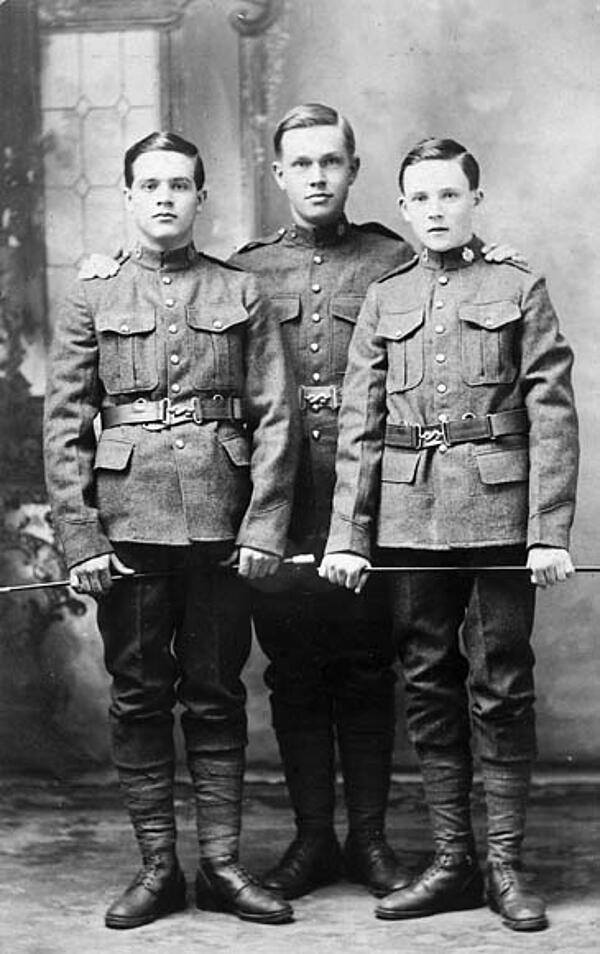Boy Soldiers
The topic of ‘boy soldiers’ fighting in World War One was a controversial one throughout the war, and by the time it was over many thousands of youths has been killed or wounded despite being too young to legally enlist.
When the war was declared in August 1914, an enormous number of men wanted to enlist including those aged between 15 and 18. Sold to the public as a battle that would be over by Christmas 1914, the recruitment officers were faced with thousands of men all hoping to take part.
The offices were told that no one under the age of 18 could enlist, and no one under the age of 19 could be posted abroad. Unfortunately, many of these offices simply did not have the time to check the age of the volunteers, who were often allowed to fight as long as they looked fit and healthy. As a result, it is believed that as many as 250,000 ‘boy soldiers’ fought during World War One.
Many of these ‘boy soldiers’ fell into the same trap. When Lord Kitchener called for volunteers for the army he hadn’t predicted the rush he would receive, and so his hard hitting poster campaign resulted in thousands of ‘boy soldiers’ feeling a need to take part.
One ‘boy soldier’, Tommy Gay, said:
“I had to go in the army because Kitchener put a poster on the wall which said: “We want you. We want you.”
Unfortunately, Tommy Gay was just 16 at the time, but had told the recruitment officer he was 18 and was told “You’re just what we want”. This was repeated across the country, with some even lying about their names so they could not be tracked down by their parents.

Lack of real evidence means it’s hard to know exactly how many ‘boy soldiers’ took part in the war, although it’s generally believed that none were aged under 14. The gravestones in Commonwealth War Grave Cemeteries also provide little help, listing a soldier’s official age rather than their actual age. However, it is believed that the youngest soldier was Horace Iles, who joined the Leeds Pals Battalion aged 14 but told the office he was 18.
The first ‘boy soldiers; arrived in Europe in May 1915, with the first battle they faced as one of ‘Kitchener’s Volunteers’ being the Battle of Loos. Unfortunately for the British Army, they suffered 50,000 casualties killed and wounded in the battle, with more than 3,600 of these under the age of 19 - meaning they shouldn’t have been there at all.
Around 500 ‘boy soldiers’ were also killed on the first day of the Battle of the Somme, with 18,000 killed or wounded by the time the battle was over.
The parents of the ‘boy soldiers’ who had made it overseas fought hard for their return, turning to Liberal MP for Mansfield Sir Arthur Markham, who found fame fighting to get the illegal soldiers home. Markham decided to use the House of Commons to publicly question the War Office about its recruitment policy, although he faced tough opposition from Under-Secretary of State for War Harold Tennant.
Many sided with Tennant as they felt it was better to ensure the army remained strong, but Markham continued to accuse the War Office of “fraud, deceit and lying”.
In contract, Tennant claimed it was the War Office that was the victim of deceit as they boys had lied about their age, but Markham felt that the government had issued confidential instructions to the Army to ignore age and choose the most suitable soldiers. However, Tennant was not going to back down:
“In this country no boys under the prescribed age as laid down by regulations have been enlisted with the knowledge of the War Office. Boys under that age are not wanted either with or without the consent of their parents.”
As the war continued, parents continued to get in touch with Markham, pleading for him to bring their sons home. However, those who had enlisted under false names were impossible to track down. In attempt to narrow down his search, Markham focused on finding the boys aged between 14 and 16.
Tennant responded to Markham’s mission by issuing a War Office directive that senior Army officers that ‘boy soldiers’ should be sent home, but that the onus for this was on the commanders in Europe. This meant that many failed to do so as they were not keen on losing trained soldiers.
The strain of the fight proved too much for Markham, who died in August 1916 aged just 50. Although he never completely succeeded, his argument did lead to the number of ‘boy soldiers’ being recruited after the Battle of the Somme dropping dramatically, particularly after the conscription was brought in as everyone was forced to provide identification.
One of the only soldiers whose gravestone includes his actual age is that of rifleman V J Strudwick in a CWG cemetery near Ypres, which lists him as just 15 years old.
MLA Citation/Reference
"Boy Soldiers". HistoryLearning.com. 2025. Web.
